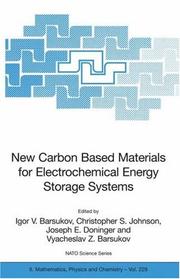| Listing 1 - 8 of 8 |
Sort by
|

ISBN: 1280962852 9781280962851 9780080471006 0080471005 9786610962853 9780080453941 0080453945 Year: 2007 Publisher: Amsterdam ; San Diego, CA ; Oxford : Elsevier,
Abstract | Keywords | Export | Availability | Bookmark
 Loading...
Loading...Choose an application
- Reference Manager
- EndNote
- RefWorks (Direct export to RefWorks)
Fuel cells have been recognized to be destined to form the cornerstone of energy technologies in the twenty-first century. The rapid advances in fuel cell system development have left current information available only in scattered journals and Internet sites. Advances in Fuel Cells fills the information gap between regularly scheduled journals and university level textbooks by providing in-depth coverage over a broad scope.The present volume provides informative chapters on thermodynamic performance of fuel cells, macroscopic modeling of polymer-electrolyte membranes, the pros
Periodical
Abstract | Keywords | Export | Availability | Bookmark
 Loading...
Loading...Choose an application
- Reference Manager
- EndNote
- RefWorks (Direct export to RefWorks)
Fuel cells --- Piles à combustible --- Fuel cells. --- Direct energy conversion --- Electric batteries --- Electric power production from chemical action --- Electrochemistry
Periodical
Abstract | Keywords | Export | Availability | Bookmark
 Loading...
Loading...Choose an application
- Reference Manager
- EndNote
- RefWorks (Direct export to RefWorks)
Fuel cells --- Piles à combustible --- Fuel cells. --- Périodiques. --- Direct energy conversion --- Electric batteries --- Electric power production from chemical action --- Electrochemistry --- Electrical Engineering --- Periodicals.

ISBN: 0120781425 9786610630448 1280630442 0080455417 9780080455419 9780120781423 Year: 2005 Publisher: Amsterdam ; Boston : Elsevier Academic Press,
Abstract | Keywords | Export | Availability | Bookmark
 Loading...
Loading...Choose an application
- Reference Manager
- EndNote
- RefWorks (Direct export to RefWorks)
Fuel cells are electrochemical energy conversion devices that convert hydrogen and oxygen into water, producing electricity and heat in the process and providing fuel efficiency and reductions in pollutants. Demand for this technology is growing rapidly. Fuel cells are being commercialized for stationary and portable electricity generation, and as a replacement for internal combustion engines in automobiles. Proton Exchange Membrane (PEM) fuel cells in particular are experiencing an upsurge. They have high power density and can vary their output quickly to meet shifts in power demand.
Fuel cells. --- Ion-permeable membranes. --- Piles à combustible --- Membranes échangeuses d'ions --- Ion exchange membranes --- Permeable membranes (Electrodialysis) --- Permselective membranes --- Electrodes, Ion selective --- Electrodialysis --- Ion exchange --- Membranes (Technology) --- Direct energy conversion --- Electric batteries --- Electric power production from chemical action --- Electrochemistry

ISBN: 1280460679 9786610460670 1402034989 1402034962 1402034970 9781402034961 9781402034985 Year: 2005 Volume: 202 Publisher: Dordrecht ; [Great Britain] : Springer,
Abstract | Keywords | Export | Availability | Bookmark
 Loading...
Loading...Choose an application
- Reference Manager
- EndNote
- RefWorks (Direct export to RefWorks)
Fuel Cells have become a potentially highly efficient sustainable source of energy and electricity for an ever-demanding power hungry world. The two main types of fuel cells ripe for commercialisation are the high temperature solid oxide fuel cell (SOFC) and the low temperature polymer electrolyte membrane fuel cell (PEM). The commercial uses of which include, but are not limited to, military, stand-by power, commercial and industrial, and remoter power. However, all aspects of the electricity market are being considered. This book has brought together a team of world-renowned experts in all aspects of fuel cell development for both SOFC and PEM in a workshop environment. The workshop held between June 6–10, 2004 was held in the capital city of the Ukraine, Kiev. The reason for the venue was that Ukraine is the third largest resource of zircon sands, a major source of material for the solid oxide fuel cell. Ukraine is looking at undertaking a very large effort in the solid oxide fuel cell arena, and hopes, one day, to be an international player in this market, and this book is an outcome from the workshop. The book focuses on the issues related to fuel cells, particularly the state-of-the-art internationally, the issues that were of particular interest for getting fuel cells fully commercialized, and advances in fuel cell materials and technology. The focus was on all types of fuel cells, but the emphasis was particularly on solid oxide fuel cells (SOFC), due to their importance to the host country. The book is an essential reference to researchers, academics and industrialists interested in up-to-date information on SOFC and PEM development.
Fuel cells --- Direct energy conversion. --- Direct generation of electricity --- Electric power production --- Energy conversion --- Energy storage --- Energy transfer --- Photoelectric cells --- Solar batteries --- Piles à combustible --- EPUB-LIV-FT SPRINGER-B LIVCHIMI --- Congresses --- Materials. --- Catalysis. --- Renewable energy sources. --- Chemistry. --- Materials Science, general. --- Renewable and Green Energy. --- Electrochemistry. --- Condensed Matter Physics. --- Physical sciences --- Alternate energy sources --- Alternative energy sources --- Energy sources, Renewable --- Sustainable energy sources --- Power resources --- Renewable natural resources --- Agriculture and energy --- Activation (Chemistry) --- Chemistry, Physical and theoretical --- Surface chemistry --- Engineering --- Engineering materials --- Industrial materials --- Engineering design --- Manufacturing processes --- Materials --- Materials science. --- Renewable energy resources. --- Condensed matter. --- Condensed materials --- Condensed media --- Condensed phase --- Materials, Condensed --- Media, Condensed --- Phase, Condensed --- Liquids --- Matter --- Solids --- Material science
Periodical
ISSN: 16146832 16146840 Year: 2011 Publisher: Weinheim : Wiley-VCH,
Abstract | Keywords | Export | Availability | Bookmark
 Loading...
Loading...Choose an application
- Reference Manager
- EndNote
- RefWorks (Direct export to RefWorks)
Physics --- Materials --- Energy storage --- Photochemistry --- Fuel cells --- Thermoelectric materials --- Research --- Materials science research --- Publications périodiques. --- Technologie énergétique. --- Piles à combustible. --- Physicochemistry --- Engineering --- Civil Engineering --- Optics & Opto Electronics --- E-journals --- Light --- Photolysis (Chemistry) --- Storage of energy --- Chemical action --- Fuel cells. --- Materials. --- Research. --- Materials science research (Title) --- Electrical engineering --- Semiconductors --- Thermoelectricity --- Direct energy conversion --- Electric batteries --- Electric power production from chemical action --- Electrochemistry --- Chemistry, Physical and theoretical --- Force and energy --- Power (Mechanics) --- Flywheels --- Pulsed power systems --- Photochemical research --- Industrial materials --- Engineering design --- Manufacturing processes --- Materials science research (Uniform Title) --- Technologie énergétique --- fuel cell. --- energy technology. --- energiteknologi --- tecnologia energetica --- energiatehnoloogia --- energiatechnológia --- energetická technológia --- energiateknologia --- енергийна технология --- energiteknik --- ενεργειακή τεχνολογία --- energetická technologie --- technologie énergétique --- teknoloġija enerġetika --- energetska tehnologija --- енергетска технологија --- tecnología energética --- Energietechnologie --- teknologji e energjisë --- energotehnoloģija --- technologia energetyczna --- tecnologia energética --- energetikos technologija --- energietechnologie --- tehnologie energetică --- teicneolaíocht fuinnimh --- energetische techniek --- tehnologija energije --- Energietechnik --- energetikai technológia --- energetická technika --- technique énergétique --- tüzelőanyag-cella --- горивна ћелија --- горивна ќелија --- brandstofcel --- bateri --- горивна клетка --- Brennstoffzelle --- dispozitiv de conversie a energiei chimice --- ċellula tal-fjuwil --- kütuseelement --- kurināmā elements --- breosla-chill --- gorivna celica --- pila de combustible --- bränslecell --- pile à combustible --- brændselscelle --- kuro elementas --- στοιχεία καυσίμου --- ogniwo paliwowe --- pilha a combustível --- goriva ćelija --- pila a combustibile --- palivový článek --- palivový článok --- polttokenno --- degalų elementas --- батерија на гориво --- агрегат --- pilha redox --- brændstofcelle --- Matériaux --- Science des matériaux --- Énergie --- Thermoélectricité --- Recherche --- Stockage --- Ciència dels materials --- Ciència dels materials. --- Matériaux --- Science des matériaux --- Énergie --- Thermoélectricité --- Publications périodiques. --- Technologie énergétique. --- Piles à combustible.


ISBN: 9781402048128 1402048106 9781402048104 1402048114 9786610625321 1280625325 1402048122 Year: 2006 Volume: 229 Publisher: Dordrecht Springer
Abstract | Keywords | Export | Availability | Bookmark
 Loading...
Loading...Choose an application
- Reference Manager
- EndNote
- RefWorks (Direct export to RefWorks)
Carbonaceous materials play a fundamental role in electrochemical energy storage systems. Carbon in the structural form of graphite is widely used as the active material in lithium-ion batteries; it is abundant, and environmentally friendly. Carbon is also used to conduct and distribute charge effectively throughout composite electrodes of supercapacitors, batteries and fuel cells. The electronic conductive pathways are critical to delivering and extracting current out of the device. However, many challenges and the understanding of the role of carbon and its stability and efficiency in charge storage applications still exists. This NATO-ARW volume contains a diverse collection of papers addressing the role of carbon in some key electrochemical systems, both conventional and emerging. These papers discuss the latest issues associated with development, synthesis, characterization and use of new advanced carbonaceous materials for electrochemical energy storage. Such systems include: metal-air primary and rechargeable batteries, fuel cells, supercapacitors, cathodes and anodes of lithium-ion and lithium polymer rechargeable batteries, as well as nanocarbon materials of the future.
halfgeleiders --- Electronics and optics of solids --- engineering --- brandstofcellen --- nanotechniek --- Electrochemistry --- fysicochemie --- Electrical engineering --- elektrochemie --- transistoren --- elektrische energie --- fysica --- Solid state physics --- Ceramic materials --- Electronics --- Batteries (Ordnance) --- Fuel cells --- Matériaux céramiques --- Electroniques matériaux --- Batteries (Science militaire) --- Piles à combustible --- Congresses --- Materials --- Congrès --- EPUB-LIV-FT LIVCHIMI SPRINGER-B --- Materials. --- Chemistry. --- Optical materials. --- Optics, Lasers, Photonics, Optical Devices. --- Energy Storage. --- Materials Science, general. --- Electrochemistry. --- Energy Systems. --- Optical and Electronic Materials. --- Optics --- Physical sciences --- Engineering --- Engineering materials --- Industrial materials --- Engineering design --- Manufacturing processes --- Congresses. --- Lasers. --- Photonics. --- Energy storage. --- Materials science. --- Energy systems. --- Electronic materials. --- Electronic materials --- Chemistry, Physical and theoretical --- Material science --- Storage of energy --- Force and energy --- Power (Mechanics) --- Flywheels --- Pulsed power systems --- New optics --- Light amplification by stimulated emission of radiation --- Masers, Optical --- Optical masers --- Light amplifiers --- Light sources --- Optoelectronic devices --- Nonlinear optics --- Optical parametric oscillators
Book
ISBN: 9781848009363 1848009356 9781848009356 9786611757243 1281757241 1848009364 Year: 2008 Publisher: London: Springer,
Abstract | Keywords | Export | Availability | Bookmark
 Loading...
Loading...Choose an application
- Reference Manager
- EndNote
- RefWorks (Direct export to RefWorks)
Proton exchange membrane (PEM) fuel cells, including H2/O2 (air) and methanol/O2 (air) fuel cells, are promising clean energy converting devices with high efficiency and low to zero emissions. Such power sources can be used in transportation, stationary, portable, and micro power applications. The key components of these fuel cells are catalysts and catalyst layers. PEM Fuel Cell Electrocatalysts and Catalyst Layers covers all of the fundamental aspects and applications of this field. The opening chapters introduce the essential topics on electrochemical theory and fuel cell catalysis, including: electrode thermodynamics, kinetics, and mass transfer; electrode/electrolyte interface electrocatalysis; electrocatalytic reactions, including O2 reduction and H2/CH3OH oxidations; quantum chemistry simulations of catalyst activity; catalyst contamination; spectroscopic methods for catalysis research; porous gas electrode theory; and catalyst layers and modeling. Later chapters investigate the synthesis, characterization, and activity validation of PEM fuel cell catalysts. All fuel cell related catalysts are reviewed, including noble and non-noble catalysts and their preparation/performance. Further chapters describe in detail the integration of the electrocatalyst/catalyst layers into the fuel cell, and their performance validation, including: catalyst layer structure function and optimization, catalyst degradation and diagnosis, and strategies to mitigate the failure modes. PEM Fuel Cell Electrocatalysts and Catalyst Layers provides a comprehensive, in-depth survey of PEM fuel cell electrocatalysts and catalyst layers, presented by internationally renowned fuel cell scientists. Researchers and engineers in the fuel cell industry will find this book a valuable resource, as will students of electrochemical engineering and catalyst synthesis.
materiaalkennis --- stroomverdeling --- energie-economie --- katalyse --- biotechnologie --- biochemie --- stroomvoorziening --- Electricity --- hernieuwbare energie --- Electrochemistry --- Enzymology --- Engineering sciences. Technology --- fysicochemie --- Materials sciences --- ingenieurswetenschappen --- elektrochemie --- BIT (biochemische ingenieurstechnieken) --- Chemical thermodynamics --- Biotechnology --- Relation between energy and economics --- Proton exchange membrane fuel cells --- Electrocatalysis. --- Catalysts. --- Piles à combustible à membrane échangeuse de protons --- Electrocatalyse --- Catalyseurs --- EPUB-LIV-FT LIVINGEN SPRINGER-B --- Electrocatalysis --- Catalysts --- Production of electric energy or. --- Chemistry. --- Catalysis. --- Materials. --- Chemical engineering. --- Renewable energy sources. --- Power Electronics, Electrical Machines and Networks. --- Electrochemistry. --- Materials Science, general. --- Industrial Chemistry/Chemical Engineering. --- Renewable and Green Energy. --- Alternate energy sources --- Alternative energy sources --- Energy sources, Renewable --- Sustainable energy sources --- Power resources --- Renewable natural resources --- Agriculture and energy --- Chemistry, Industrial --- Engineering, Chemical --- Industrial chemistry --- Engineering --- Chemistry, Technical --- Metallurgy --- Engineering materials --- Industrial materials --- Engineering design --- Manufacturing processes --- Activation (Chemistry) --- Chemistry, Physical and theoretical --- Surface chemistry --- Physical sciences --- Materials --- Power electronics. --- Materials science. --- Renewable energy resources. --- Material science --- Electronics, Power --- Electric power --- Electronics --- Proton exchange membrane fuel cells.
| Listing 1 - 8 of 8 |
Sort by
|

 Search
Search Feedback
Feedback About UniCat
About UniCat  Help
Help News
News